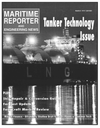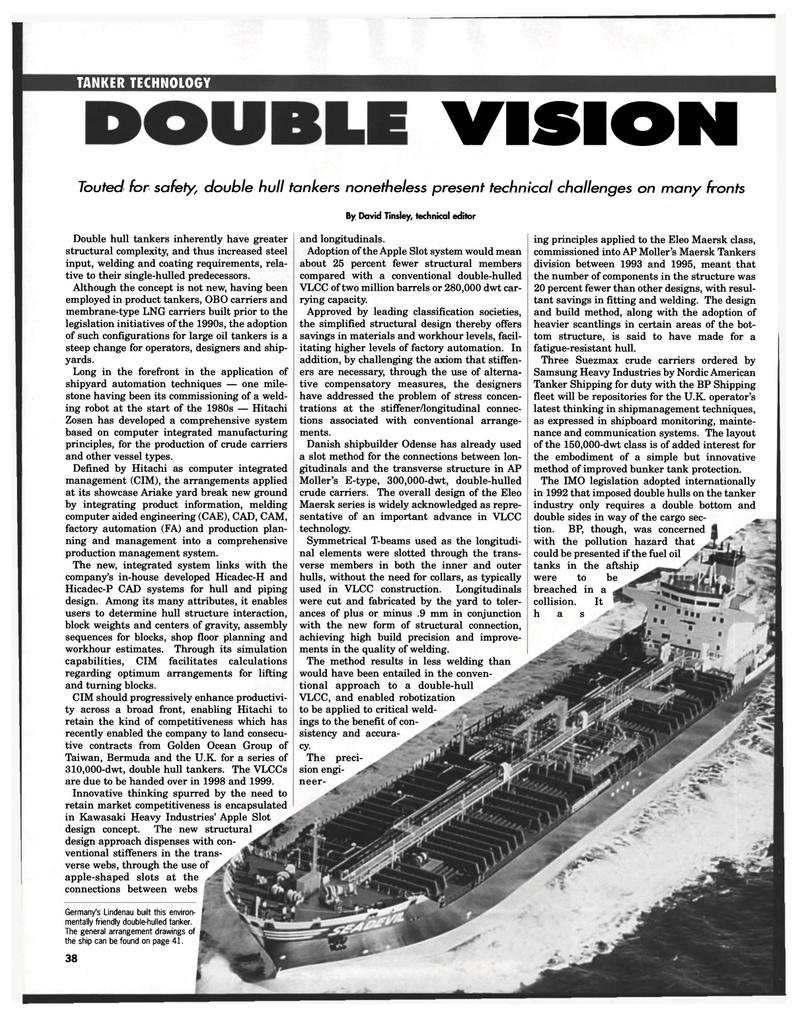
Page 30: of Maritime Reporter Magazine (March 1997)
Read this page in Pdf, Flash or Html5 edition of March 1997 Maritime Reporter Magazine
TANKER TECHNOLOGY
VISION
Touted for safety-f double hull tankers nonetheless present technical challenges on many fronts
By David Tinsley, technical editor and longitudinals.
Adoption of the Apple Slot system would mean about 25 percent fewer structural members compared with a conventional double-hulled
VLCC of two million barrels or 280,000 dwt car- rying capacity.
Approved by leading classification societies, the simplified structural design thereby offers savings in materials and workhour levels, facil- itating higher levels of factory automation. In addition, by challenging the axiom that stiffen- ers are necessary, through the use of alterna- tive compensatory measures, the designers have addressed the problem of stress concen- trations at the stiffener/longitudinal connec- tions associated with conventional arrange- ments.
Danish shipbuilder Odense has already used a slot method for the connections between lon- gitudinals and the transverse structure in AP
Moller's E-type, 300,000-dwt, double-hulled crude carriers. The overall design of the Eleo
Maersk series is widely acknowledged as repre- sentative of an important advance in VLCC technology.
Symmetrical T-beams used as the longitudi- nal elements were slotted through the trans- verse members in both the inner and outer hulls, without the need for collars, as typically used in VLCC construction. Longitudinals were cut and fabricated by the yard to toler- ances of plus or minus .9 mm in conjunction with the new form of structural connection, achieving high build precision and improve- ments in the quality of welding.
The method results in less welding than would have been entailed in the conven- tional approach to a double-hull
VLCC, and enabled robotization to be applied to critical weld- ings to the benefit of con- sistency and accura- cy-
The preci- sion engi- neer- ing principles applied to the Eleo Maersk class, commissioned into AP Moller's Maersk Tankers division between 1993 and 1995, meant that the number of components in the structure was 20 percent fewer than other designs, with resul- tant savings in fitting and welding. The design and build method, along with the adoption of heavier scantlings in certain areas of the bot- tom structure, is said to have made for a fatigue-resistant hull.
Three Suezmax crude carriers ordered by
Samsung Heavy Industries by Nordic American
Tanker Shipping for duty with the BP Shipping fleet will be repositories for the U.K. operator's latest thinking in shipmanagement techniques, as expressed in shipboard monitoring, mainte- nance and communication systems. The layout of the 150,000-dwt class is of added interest for the embodiment of a simple but innovative method of improved bunker tank protection.
The IMO legislation adopted internationally in 1992 that imposed double hulls on the tanker industry only requires a double bottom and double sides in way of the cargo sec- tion. BP, though, was concerned with the pollution hazard that could be presented if the fuel oil tanks in the aftship were to be breached in a collision. It has
Double hull tankers inherently have greater structural complexity, and thus increased steel input, welding and coating requirements, rela- tive to their single-hulled predecessors.
Although the concept is not new, having been employed in product tankers, OBO carriers and membrane-type LNG carriers built prior to the legislation initiatives of the 1990s, the adoption of such configurations for large oil tankers is a steep change for operators, designers and ship- yards.
Long in the forefront in the application of shipyard automation techniques — one mile- stone having been its commissioning of a weld- ing robot at the start of the 1980s — Hitachi
Zosen has developed a comprehensive system based on computer integrated manufacturing principles, for the production of crude carriers and other vessel types.
Defined by Hitachi as computer integrated management (CIM), the arrangements applied at its showcase Ariake yard break new ground by integrating product information, melding computer aided engineering (CAE), CAD, CAM, factory automation (FA) and production plan- ning and management into a comprehensive production management system.
The new, integrated system links with the company's in-house developed Hicadec-H and
Hicadec-P CAD systems for hull and piping design. Among its many attributes, it enables users to determine hull structure interaction, block weights and centers of gravity, assembly sequences for blocks, shop floor planning and workhour estimates. Through its simulation capabilities, CIM facilitates calculations regarding optimum arrangements for lifting and turning blocks.
CIM should progressively enhance productivi- ty across a broad front, enabling Hitachi to retain the kind of competitiveness which has recently enabled the company to land consecu- tive contracts from Golden Ocean Group of
Taiwan, Bermuda and the U.K. for a series of 310,000-dwt, double hull tankers. The VLCCs are due to be handed over in 1998 and 1999.
Innovative thinking spurred by the need to retain market competitiveness is encapsulated in Kawasaki Heavy Industries' Apple Slot design concept. The new structural design approach dispenses with con- ventional stiffeners in the trans- verse webs, through the use of apple-shaped slots at the connections between webs
Germany's Lindenau built this environ- mentally friendly double-hulled tanker.
The general arrangement drawings of the ship can be found on page 41. 38

 29
29

 31
31
